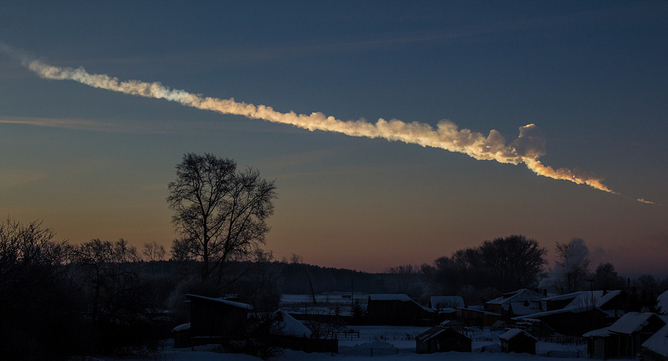
The destructive meteor trace that fell on Chelyabinsk, Russia, in 2013.
Credit: Alex Alishevskikh/Flickr, CC BY-SA
This article was originally published at The Conversation. The publication contributed the article to Space.com’s Expert Voices: Op-Ed & Insights.
There is nothing more certain in life than death – a cheerful thought for a dismal February. Even though we are aware of that inevitability, we don’t expect death literally to strike out of an empty sky, which reportedly is what happened to Kamraj , a bus driver in Vellore, a town in the Indian state of Tamil Nadu.
Accounts of the event near the Bharathidasan Engineering College campus are fairly unanimous: there was a sudden explosion, a crater appeared, windows in surrounding buildings were blown out and flying debris struck several people in the vicinity, including Kamraj. At first, it was thought that the explosion was caused by the inadvertent detonation of material at a building site. But police later ruled that out, as they couldn’t find any traces of explosives.

Cosmic dust grain.
Credit: e Donald E. Brownlee, University of Washington, Seattle, and Elmar Jessberger, Institut für Planetologie, Münster, Germany/wikimedia., CC BY-SA
The report that something fell out of the sky has to be taken seriously. Meteorites do just randomly fall out of the sky all over the Earth’s surface, at a rate of about 40,000 tonnes of rock and metal each year. Admittedly, most of this material falls as particles of dust less than 100 micrometres across, but every year, about 5000 football-sized objects land. However, as the majority of our planet is actually uninhabited, most of these fall in the sea or in unpopulated regions, meaning we very rarely see them .
Spectacular events, such as at Chelyabinsk in Russia almost exactly three years ago, when a huge, bright fireball caused a blast that shook buildings, broke windows and injured over 1000 people, demonstrate the destructive power of a meteorite impact. The Chelyabinsk meteorite was much bigger than a football, and is the sort of event that occurs once in a century.
Meteorite hitting Chelyabinsk in 2013.
Meteorites have been studied scientifically for around 200 years. There is an international society that keeps records of all meteorites and oversees their naming and where they were found (or seen to fall). There are approximately 50,000 known meteorites – and not one of them has been associated with a human fatality. Cows – yes , dogs – possibly , but so far no people.
Was this a meteorite fall?
As a professional meteoriticist who curated the UK’s national collection for over a decade, I read accounts of the Tamil Nadu fall with great interest. But given the apparent noise that accompanied the explosion, and the extent of the damage, I am slightly surprised that there are no reports of a fireball, or even a bright light. Something travelling fast enough to make such a noise should have been visible as it plunged through the atmosphere, made incandescent by frictional heating.
If the explosion was not a meteorite, what might it have been? There has been speculation that it was “space junk ” – a piece from a defunct satellite or failed rocket launch – hurtling back to Earth. Certainly there have been reports of such events happening, but we can track the largest such objects, the sort that might lead to explosive impacts, and predict where they will fall . So it is unlikely that we wouldn’t know about it. Could it have fallen from an aircraft? Again, it’s a possibility, as that does happen, but it seems unlikely that the aircraft wasn’t affected in the process.
Material has been recovered from the site, and there is a fuzzy picture of a ten-gram sized stone. But reports state the object was recovered later from behind the college canteen, and that it looked like “eeyam” – which is tin or lead. From personal experience, I know that people looking for meteorite fragments tend to pick up metallic-looking objects, as that is what meteorites are often thought to be made from.
And that is true, but there are many more stony meteorites than there are metallic ones. The fragment is going to be analysed, so we should know soon if the material is natural or artificial. More definitive results might also come from the soil samples collected from the crater.
Whatever the origin of the crater, there is an outcome that must not be forgotten: Kamraj, an unfortunate bystander, was killed in the event. He may achieve notoriety as the first human fatality from a meteorite fall, or become a footnote in the history of space exploration. But to his family and friends, that is much less important than the fact they have lost a man they loved and valued.
Monica Grady , Professor of Planetary and Space Sciences, The Open University
This article was originally published on The Conversation . Read the original article . Follow all of the Expert Voices issues and debates — and become part of the discussion — on Facebook , Twitter and Google + . The views expressed are those of the author and do not necessarily reflect the views of the publisher. This version of the article was originally published on Space.com .

Comments are closed.